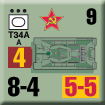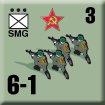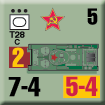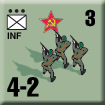| Panzer Grenadier: Workers & Peasants
Scenario Preview, Part One
February 2014
The Red Army of Workers and Peasants (also known to Panzer Grenadier players by its Russian acronym, RKKA) has been a centerpiece of the Panzer Grenadier series ever since the beginning. The original Panzer Grenadier game (and later the expanded version, Eastern Front) included more than a full sheet of Red Army units of all types from the early years of the war. These same pieces have made appearances in many subsequent scenarios published in Panzer Grenadier book supplements. And while the wide variety of unit types available in Eastern Front has allowed us to publish many subsequent scenarios using just that counter mix, the relatively small number of Red Army leaders included in Eastern Front has also constrained us to a certain extent.
This was intentional, since that gameís focus was the early stages of Operation Barbarossa. At that time, Josef Stalinís purges had left the Red Army officer corps woefully undermanned and lacking in quality and experience. So while the paucity of Red Army officers in Eastern Front scenarios adds realism to that game, it constrained us from publishing scenarios on some really large Red Army battles.
 That problem is solved with Workers and Peasants, which includes a large number of Red Army officers whose quality reflects that of the Soviet officer corps in the early days of the war. Mike Perryman has used those new leaders to create a wide variety of scenarios chronicling the desperate fighting on the Eastern Front in the summer and fall of 1941. Not all the scenarios include large formations, but the new Red Army officers in Workers and Peasants have allowed Mike to craft challenging scenarios whose victory conditions donít need to be skewed against the Germans due to a lack of sufficient Red Army officers. That problem is solved with Workers and Peasants, which includes a large number of Red Army officers whose quality reflects that of the Soviet officer corps in the early days of the war. Mike Perryman has used those new leaders to create a wide variety of scenarios chronicling the desperate fighting on the Eastern Front in the summer and fall of 1941. Not all the scenarios include large formations, but the new Red Army officers in Workers and Peasants have allowed Mike to craft challenging scenarios whose victory conditions donít need to be skewed against the Germans due to a lack of sufficient Red Army officers.
Workers and Peasants includes 25 scenarios divided into four sections. The first three sections include battles fought by the German Army Groups North, Center and South (respectively). The fourth section chronicles the battles around the town of Borodino, where the largest battle of Napoleonís invasion of Russia took place more than a century earlier.
ARMY GROUP SOUTH
Scenario One
Opening Moves
23 June 1941
 On the second day of Operation Barbarossa, the two foot units of German XLVII Motorized Corps were to open a hole in Soviet lines for the panzers to exploit. The Red Army units facing them had been better prepared for the initial German onslaught than their brethren up north, and had bent but not broken. On the second day of Operation Barbarossa, the two foot units of German XLVII Motorized Corps were to open a hole in Soviet lines for the panzers to exploit. The Red Army units facing them had been better prepared for the initial German onslaught than their brethren up north, and had bent but not broken.
Note: This scenario uses boards and pieces from Eastern Front and Road to Berlin, and pieces from 1940: The Fall of France. Only use leaders from Eastern Front and this supplement.
Conclusion
At the opening of Operation Barbarossa the Wehrmacht stood at peak efficiency. This allowed them to drive the inexperienced defenders back despite their best efforts. The panzers were soon pouring through the opening.
Commentary
This is a very large battle between two infantry divisions that gets most of the new Soviet leaders from Workers and Peasants into the action right away. The Soviets have nearly equal numbers to the Germans, but higher German morale plus German air support makes it possible for them to break through Soviet lines.
Scenario Two
A Glimpse of the Future
23 June 1941
After the infantry had ruptured the Russian lines, the panzers went forward to exploit the gaps. Knowing that Soviet armored units were deployed far from the front, no trouble was expected. The Germans couldn't have been more wrong.
Note: This scenario uses boards from Road to Berlin and pieces from Eastern Front.
Conclusion
While previous combatants had been unable to contain the panzers, the Red Army decided that using a number of antitank guns deployed in depth was the answer. Here the concept proved its merit, and the panzers were unable to exploit the infantry's success until Soviet 1st Antitank Brigade was forced to fall back due to pressure on its flanks. The concept would be constantly developed until it came to fruition at Kursk.
Commentary
This is a medium-sized scenario in which a German armored column tries to push its way through a Soviet infantry force backed by anti-tank guns. The Germans have the Soviets outgunned 3 to 1, and the Soviets have nothing but 76.2mm artillery with which to oppose the German armor. The Soviets win if they hold the road or kill enough German steps.
Scenario Three
Blocking Force
5 July 1941
 In the first days of July, Soviet 8th Mechanized Corps counterattacked the oncoming Germans and soon found itself surrounded. In the subsequent breakout, one of its three divisions (34th Tank) lost over 10,000 men and most of its vehicles. The other two divisions managed to extricate themselves somewhat intact, but one of them (7th Mechanized) was immediately ordered to block a direct German assault on the Stalin Line. In the first days of July, Soviet 8th Mechanized Corps counterattacked the oncoming Germans and soon found itself surrounded. In the subsequent breakout, one of its three divisions (34th Tank) lost over 10,000 men and most of its vehicles. The other two divisions managed to extricate themselves somewhat intact, but one of them (7th Mechanized) was immediately ordered to block a direct German assault on the Stalin Line.
Note: This scenario uses boards and pieces from Eastern Front, and pieces from 1940: The Fall of France. Only use leaders from Eastern Front.
Conclusion
Seventh Mechanized Division had been issued 250 light tanks before the war started. Mechanical breakdowns, air attacks and losses during the breakout had significantly reduced that number. Their howitzer regiment also had had to be left behind as they had never received the tractors to move their guns. They were easily brushed aside by the Germans, who would reach the Stalin Line by nightfall.
Commentary
Here the Germans have the Soviets outgunned 2 to 1, the Soviets have no off-board artillery and their tanks are sitting ducks since the Germans out-range them and can penetrate their armor easily. So the Soviets donít have much of anything with which to stop the Germans, but they have to try. The German player wins if he or she scores at least twice as many VPs as the Soviet player, and any other result is a Soviet victory.
Scenario Four
Over the River
25 November 1941
The Germans entered Rostov on the 20th and secured the city two days later. Recognizing the vulnerability of his position, General Ewald von Kleist wanted to withdraw to a more defensible location but was overruled by Berlin. On the 25th the Soviets swarmed over the Don River, confirming Kleist's fears.
Note: This scenario uses boards from 1940: The Fall of France, and pieces from Eastern Front, Road to Berlin and Sinister Forces. Only use German leaders from Sinister Forces and Soviet leaders from Eastern Front and this supplement.
Conclusion
Led by "Panzer Meyer" (who would later write a popular book on the recon battalion of SS Lifeguard), the Germans managed to turn back the first three waves of Russian attackers. The fourth wave broke into the German lines, where it was routed by fresh troops. SS Lifeguard claimed 300 Russians dead and 400 captured while admitting to two dead and seven wounded.
Commentary
 A river crossing scenario with thin ice - you can cross pretty easily, but vehicles might plunge through into the freezing waters below. That makes for a fun scenario with huge waves of Soviet infantry (44 platoons!) storming over the ice. A river crossing scenario with thin ice - you can cross pretty easily, but vehicles might plunge through into the freezing waters below. That makes for a fun scenario with huge waves of Soviet infantry (44 platoons!) storming over the ice.
ARMY GROUP CENTER
Scenario One
A Stroke of Luck
6 July 1941
On July 6, the Red Army 7th Mechanized Corps was tasked with applying enough pressure to at least stop the Hitlerites if not outright defeat them. Their Kommissars made sure everyone understood the gravity of the situation and that they had been lavishly equipped by the Motherland for just such an effort. Even in the 18th Tank Division (which contained only older light tanks), it was stressed that failure was not an option.
Note: This scenario uses a board from Road to Berlin, boards and pieces from Eastern Front, and pieces from Arctic Front Deluxe. Use only leaders from Eastern Front Deluxe and this supplement.
Conclusion
Fired up by their Kommisar and supported by some light tanks, the riflemen pressed forward and surprised the Germans, who had arrogantly neglected security while concentrating for their own attack. Caught in the open by an inspired enemy, the Germans fell back 18 miles. There the Soviets would themselves neglect security and be decimated.
Commentary
Here the Soviets greatly outnumber the Germans, but theyíre attacking a higher-morale enemy in mainly open ground so theyíll lose strength fast to opportunity fire. They must fight to take road and town hexes and kill German steps. The Germans, taken unawares by the Soviet attack, are spread out on the road.
Scenario Two
Polotsk Fortified Region
10 July 1941
 The advancing panzers had deemed the West Dvina River at Polotsk too heavily fortified to attempt a crossing there. They had instead sped onward and left the trailing infantry to deal with the problem. The advancing panzers had deemed the West Dvina River at Polotsk too heavily fortified to attempt a crossing there. They had instead sped onward and left the trailing infantry to deal with the problem.
Note: This scenario uses a board and pieces from 1940: The Fall of France, a board from Battle of the Bulge and pieces from Eastern Front and Road to Berlin. Only use leaders from Eastern Front Deluxe and this supplement.
Conclusion
Though other Soviet units were streaming eastward at this point in the campaign, the Soviet soldiers manning Polotsk Fortified Region had no intention of moving. The German plan for an easy establishment of a bridgehead on the West Dvina came up against hard reality. Over the next few days the fighting here turned especially bitter until the Soviet defenders where finally forced to withdraw on the 16th.
Commentary
The Red Army is outnumbered by better than two-to-one, and that's before all the German advantages in morale, leadership and especially artillery. Still, they are entrenched behind a river line with special rules giving them unusually good leadership.
Scenario Three
Unrealistic Expectations
16 July 1941
As part of their most recent effort to drive the hated Hitlerites back, Stavka ordered the 219th Mechanized Division to pocket 4th Panzer Division so it could be destroyed at their convenience. Once that was accomplished, they were to open up an escape route for the beleaguered 13th Army fighting at Mogilev. This despite the fact all of their armor had long since been distributed among the tank divisions of 25th Mechanized Corps.
Note: This scenario uses boards and pieces from Road to Berlin and Eastern Front. Only use leaders from Eastern Front and this supplement.
Conclusion
The lack of supporting armor doomed the attack to failure before it was launched. The only surprising thing was the ease in which it was brushed aside. Stavka was forced to look elsewhere for a way to stop the rampaging panzers and free 13th Army.
Commentary
Here is another scenario in which the Germans enter on the west edge of the board and must try to get units through Soviet lines and off the east edge of the board. The Germans have a medium-sized armored force up against a very large Soviet infantry force with little armor support.
Scenario Four
A Ray of Hope
13 July 1941
 Stavka had ordered 63rd Rifle Corps to force its way over the Dnepr River and liberate Rogachev. Not content with one unrealistic order, Stavka then ordered that the defeated enemy was to be driven westward as fast as possible. This in spite of the fact that Red Army units were having trouble holding their ground, much less advancing. Stavka had ordered 63rd Rifle Corps to force its way over the Dnepr River and liberate Rogachev. Not content with one unrealistic order, Stavka then ordered that the defeated enemy was to be driven westward as fast as possible. This in spite of the fact that Red Army units were having trouble holding their ground, much less advancing.
Note: This scenario uses a board from Battle of the Bulge and boards and pieces from Eastern Front and Road to Berlin. Only use leaders from Eastern Front and this supplement.
Conclusion
Exceeding all expectations, 63rd Rifle Corps not only secured Rogachev but advanced another six miles before being stopped. It all went for naught as a short week later they were forced to withdraw to avoid being encircled.
Commentary
This is a fairly large scenario, with a hefty infantry-based Soviet force on the attack against dug-in German infantry. Each side has a sprinkling of armor support, but this is going to be an infantry fight across rivers and through woods.
Scenario Five
Vilified
24 July 1941
Group Kachalov had launched an attack yesterday designed to cut off the German spearheads operating south of Smolensk. Their advance northward had been checked by Infantry Regiment Grossdeutschland. Today two rifle divisions would occupy Grossdeutschland while the 104th Tank Division probed toward their open left flank.
Note: This scenario requires a boards and pieces from Eastern Front and Road to Berlin, and pieces from 1940: The Fall of France and Arctic Front Deluxe. Only use leaders from Eastern Front and this supplement.
Conclusion
While Kachalovís tanks probed forward, 18th Panzer Division rushed in to fill the void. In a near-run thing they managed to turn the Red Army tankers back before they could hit Grossdeutschlandís flank. Soon a German counterattack would entrap and destroy Group Kachalov. The Kremlin would vilify the dead Kachalov by saying "while in encirclement ... [he] ... displayed cowardice and fell captive." In actual fact, he had died trying to lead his troops out of the trap. Much later the Soviets would rehabilitate him.
Commentary
 This one is a meeting engagement between a medium-sized German armored force and a much larger Soviet armored force with lower morale and poorer-quality tanks. Both sides need to eliminate enemy units, and the Soviets have to get units off the north edge of the board while the Germans must stop them. This one is a meeting engagement between a medium-sized German armored force and a much larger Soviet armored force with lower morale and poorer-quality tanks. Both sides need to eliminate enemy units, and the Soviets have to get units off the north edge of the board while the Germans must stop them.
Scenario Six
Still Trying
30 August 1941
Marshall Zhukov had been sent by Stavka to save the situation around Yelnia. Given command of Reserve Front he promptly launched limited counterattacks while planning bigger things. On August 30th he struck the Yelnia salient from three sides with the intention of surrounding and then destroying the invaders.
Note: This scenario uses boards and pieces from Eastern Front Deluxe.
Conclusion
102nd Tank Division had distinguished itself in the fighting around Smolensk that had cost it most of its tanks. On this day they attacked the German 137th Infantry Division in cooperation with two rifle divisions, and slowly worked their way forward. By the September 2nd the 137th reported the loss of 1,200 men, and within days the Germans would abandon the Yelnia salient.
Commentary
A Soviet tank attack, and the Red Army has the edge in numbers and artillery, with even morale. Both sides are trying to eliminate enemy units and take or hold town hexes, and the Soviets in addition hope to drive their way across the map while the Germans try to stop them.
Scenario Seven
Pogar Bound
31 August 1941
General Eremenko assumed command of Briansk Front with orders to stop the rampaging panzers of Guderian. But before that could even be contemplated, the twelve mile gap that separated Briansk and Central Front needed to be addressed. The first step in accomplishing that was securing Pogar, and Eremenko sent in more troops after a failed attempt on August 30.
Note: This scenario requires boards and pieces from Eastern Front and Road to Berlin, and boards from 1940: The Fall of France and Elsenborn Ridge. Only use leaders from Eastern Front and this supplement.
Conclusion
108th Tank Division was a formidable opponent as it was equipped with only the newest model tanks. Nevertheless, the experienced panzer crews adapted quickly to the situation and gave some ground but remained in control of Pogar.
Commentary
A large scenario with a powerful combined Soviet force of tanks, infantry and cavalry attacking a smaller German armored force in relatively open terrain. The German tank reinforcements are numerous and strong, but the RKKA has the T-34 and KV-1 and has them in quantity. Large tank battle scenarios like this one are the reason we published Workers & Peasants.
That covers the first half of Workers and Peasants. Next up is the Army Group North section, and after that Borodino 1941.
Click here to order Workers and Peasants TODAY! |
